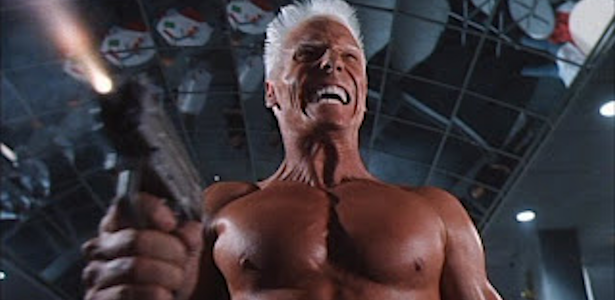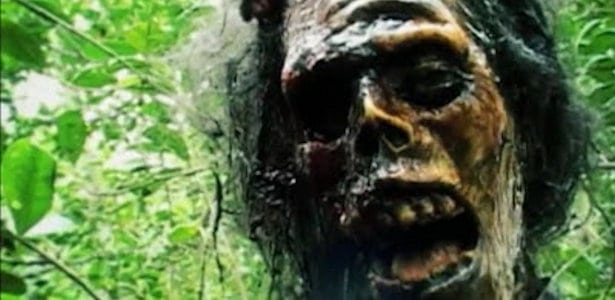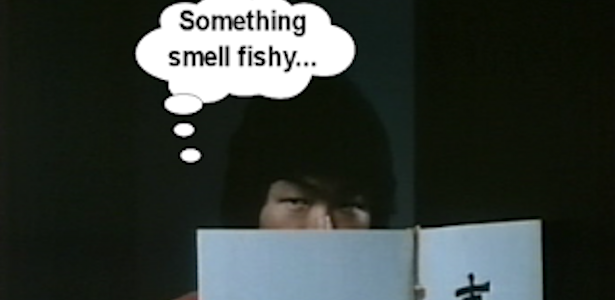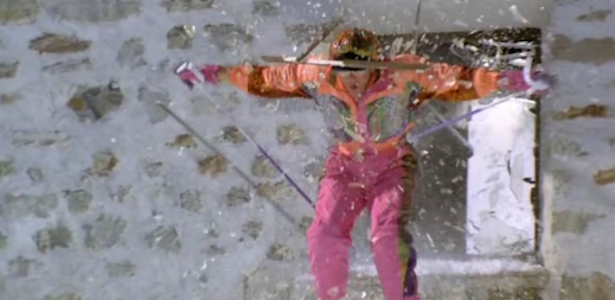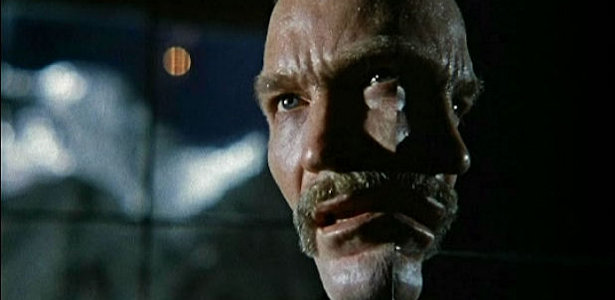With a name like Coppola, you'd expect the nephew of that wine-maker guy to go all high profile and work in the majors like his brother, err, Nicolas Cage. I mean, if you don't have nepotism in Hollywood, what do you have? Nope, Christopher Coppola has managed to nurse along a 27 year career doing his own little thing - and shooting some TV shows. His own little thing started with DRACULA'S WIDOW (1988), a horror comedy that was neither scary or funny, but was just odd enough to make it strangely enjoyable. He also worked for Charles Band during the Moonbeam phase directing the weird little sci-fi western CLOCKMAKER (1998), written by the great Benjamin Carr. Again, something of a misfire, but a strangely enjoyable one.
In the year 2000 (I always wanted to say that), Coppola released an adaptation of "Grafik Muzik", a satire of superhero comics by Eisner Award winner Mike Allred, who went on to work on high profile Marvel titles and recently created Vertigo Comics' "iZombie" which was the basis for the TV series of the same name.
 Set in a retro-noir modern day, a pair of corrupt federal agents are shot down in the street and sent to a kisch-cool hell where the Big D (Robert Goulet) spends his time tormenting souls and lying on a couch, spilling his problems to Sigmund Freud: "I keep feeling everybody hates me." Our G-Men, Dean Crept (William Forsythe) and Mike Mattress (Tate Donovan) decide to grab the Devil's special crystal allowing them to go back to the land of the living to do some good deeds in the hopes that it will get them into heaven. As Crept tells Mattress "Good deeds Matt, good deeds. There'll be plenty of time for broads when we're in solid with the Big Guy."
Set in a retro-noir modern day, a pair of corrupt federal agents are shot down in the street and sent to a kisch-cool hell where the Big D (Robert Goulet) spends his time tormenting souls and lying on a couch, spilling his problems to Sigmund Freud: "I keep feeling everybody hates me." Our G-Men, Dean Crept (William Forsythe) and Mike Mattress (Tate Donovan) decide to grab the Devil's special crystal allowing them to go back to the land of the living to do some good deeds in the hopes that it will get them into heaven. As Crept tells Mattress "Good deeds Matt, good deeds. There'll be plenty of time for broads when we're in solid with the Big Guy."
Their plan to do these good deeds is to set up a detective agency and do... uhhh, good deeds. To get the money to set up this business of doing good deeds, they decide to put the squeeze one of their former stoolies, Buster (Bobcat Goldthwait). Buster suspects foul things are afoot as Dean and Mike do not appear to be dead like they are supposed to be. Unfortunately for him, before he can draw his gun, Mike blows a hole in his head, and the pair help themselves to his clothes, money and his '65 Caddie. He was a crook, therefore, it was a good deed, right?
 Their first case is from a doe-eyed, platinum blond, Gloria Lake (Vanessa Angel), who wants the guys to snoop around her wealthy husband Greydon Lake (Barry Newman), who she suspects is cheating on her. Greydon is involved with a scientist, Dr. Boiffard (David Huddleston) who is in turn assisted by Martin and Pete (Charles Fleischer) a man and his seemingly interdependently minded hand-puppet, in experiments to transplant the essence of a person into another body. Got all that? Good, because that ain't the half of it.
Their first case is from a doe-eyed, platinum blond, Gloria Lake (Vanessa Angel), who wants the guys to snoop around her wealthy husband Greydon Lake (Barry Newman), who she suspects is cheating on her. Greydon is involved with a scientist, Dr. Boiffard (David Huddleston) who is in turn assisted by Martin and Pete (Charles Fleischer) a man and his seemingly interdependently minded hand-puppet, in experiments to transplant the essence of a person into another body. Got all that? Good, because that ain't the half of it.
There are also two cops looking into Buster's murder, Lt. Langdon (Gary Busey) who wears a black trenchcoat and pink lip-gloss and Dalton (Zach Galligan), a straight from the academy nerd. At one point Dalton tells Langdon that he respects his choice in personal life as a homosexual to which Langdon screams in his face "I am a sadistic, leathermaster homosexual and I will tease your sensibilities." Granted not a particularly funny line on paper, but when it is being spit out through clenched teeth by a deranged Gary Busey, it turns into comedy gold. This pretty much describes the rest of the movie. On paper, it doesn't sound so great, but with an great cast who are all in, it is actually pretty damn cool.
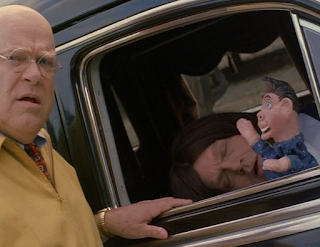 As if that weren't enough, we also have the obligatory sexpot secretary, Marete Morrisey (Kari Wuhrer); Weenie Man (Paul Rodriguez), a minion of the Devil, who is (ahem) hell-bent on catching the G-Men and returning them, and the crystal, to the boss; a clearly unbalanced individual who likes to call himself Cheetah Man (Gregory Sporleder) and runs around the rooftops sticking his nose into the case; oh, and Buster makes a bizarre return after his essence is implanted into a pink robot, which he is not entirely happy about.
As if that weren't enough, we also have the obligatory sexpot secretary, Marete Morrisey (Kari Wuhrer); Weenie Man (Paul Rodriguez), a minion of the Devil, who is (ahem) hell-bent on catching the G-Men and returning them, and the crystal, to the boss; a clearly unbalanced individual who likes to call himself Cheetah Man (Gregory Sporleder) and runs around the rooftops sticking his nose into the case; oh, and Buster makes a bizarre return after his essence is implanted into a pink robot, which he is not entirely happy about.
Coppola does a fantastic job of making the movie look like a comic book with garish colors and oblique angles on what is clearly a limited budget. Some of the cast, such as Angel and Rodriguez, chew the scenery to the point where they must have had to rebuild the sets after every take. Also, Coppola's love of cheap wigs is more than well represented here. Why does Bobcat, in his brief screen-time, need a tacky toup is a real head-scratcher. It would have been funny to see him in his robot form continue to wear the hair-piece, but instead he wears a knit black beanie in order to disguise himself as a human. But those are minor quibbles.
With all of this insanity bouncing around in a 98 minute movie, you'd think it would be just one big clusterfuck, which it kind of is, but for some reason it works surprisingly well, warts and all. It's a comic book satire with a heavy film noir influence with camera work that makes ERNEST GOES TO JAIL (1990) seems sedate. It also sports some great snappy dialogue like when Matt looks at Mrs. Lake and says "If I was the marrying kind, I'd cheat on my wife with her." It may not make all of Allred's fans happy, but this is probably Coppola's crowning achievement, in spite of the fact that, as someone on the IMDb pointed out, he was the director of "the GRANDFATHER saga". No, really. Someone said that.
In the year 2000 (I always wanted to say that), Coppola released an adaptation of "Grafik Muzik", a satire of superhero comics by Eisner Award winner Mike Allred, who went on to work on high profile Marvel titles and recently created Vertigo Comics' "iZombie" which was the basis for the TV series of the same name.
 Set in a retro-noir modern day, a pair of corrupt federal agents are shot down in the street and sent to a kisch-cool hell where the Big D (Robert Goulet) spends his time tormenting souls and lying on a couch, spilling his problems to Sigmund Freud: "I keep feeling everybody hates me." Our G-Men, Dean Crept (William Forsythe) and Mike Mattress (Tate Donovan) decide to grab the Devil's special crystal allowing them to go back to the land of the living to do some good deeds in the hopes that it will get them into heaven. As Crept tells Mattress "Good deeds Matt, good deeds. There'll be plenty of time for broads when we're in solid with the Big Guy."
Set in a retro-noir modern day, a pair of corrupt federal agents are shot down in the street and sent to a kisch-cool hell where the Big D (Robert Goulet) spends his time tormenting souls and lying on a couch, spilling his problems to Sigmund Freud: "I keep feeling everybody hates me." Our G-Men, Dean Crept (William Forsythe) and Mike Mattress (Tate Donovan) decide to grab the Devil's special crystal allowing them to go back to the land of the living to do some good deeds in the hopes that it will get them into heaven. As Crept tells Mattress "Good deeds Matt, good deeds. There'll be plenty of time for broads when we're in solid with the Big Guy."Their plan to do these good deeds is to set up a detective agency and do... uhhh, good deeds. To get the money to set up this business of doing good deeds, they decide to put the squeeze one of their former stoolies, Buster (Bobcat Goldthwait). Buster suspects foul things are afoot as Dean and Mike do not appear to be dead like they are supposed to be. Unfortunately for him, before he can draw his gun, Mike blows a hole in his head, and the pair help themselves to his clothes, money and his '65 Caddie. He was a crook, therefore, it was a good deed, right?
 Their first case is from a doe-eyed, platinum blond, Gloria Lake (Vanessa Angel), who wants the guys to snoop around her wealthy husband Greydon Lake (Barry Newman), who she suspects is cheating on her. Greydon is involved with a scientist, Dr. Boiffard (David Huddleston) who is in turn assisted by Martin and Pete (Charles Fleischer) a man and his seemingly interdependently minded hand-puppet, in experiments to transplant the essence of a person into another body. Got all that? Good, because that ain't the half of it.
Their first case is from a doe-eyed, platinum blond, Gloria Lake (Vanessa Angel), who wants the guys to snoop around her wealthy husband Greydon Lake (Barry Newman), who she suspects is cheating on her. Greydon is involved with a scientist, Dr. Boiffard (David Huddleston) who is in turn assisted by Martin and Pete (Charles Fleischer) a man and his seemingly interdependently minded hand-puppet, in experiments to transplant the essence of a person into another body. Got all that? Good, because that ain't the half of it.There are also two cops looking into Buster's murder, Lt. Langdon (Gary Busey) who wears a black trenchcoat and pink lip-gloss and Dalton (Zach Galligan), a straight from the academy nerd. At one point Dalton tells Langdon that he respects his choice in personal life as a homosexual to which Langdon screams in his face "I am a sadistic, leathermaster homosexual and I will tease your sensibilities." Granted not a particularly funny line on paper, but when it is being spit out through clenched teeth by a deranged Gary Busey, it turns into comedy gold. This pretty much describes the rest of the movie. On paper, it doesn't sound so great, but with an great cast who are all in, it is actually pretty damn cool.
 As if that weren't enough, we also have the obligatory sexpot secretary, Marete Morrisey (Kari Wuhrer); Weenie Man (Paul Rodriguez), a minion of the Devil, who is (ahem) hell-bent on catching the G-Men and returning them, and the crystal, to the boss; a clearly unbalanced individual who likes to call himself Cheetah Man (Gregory Sporleder) and runs around the rooftops sticking his nose into the case; oh, and Buster makes a bizarre return after his essence is implanted into a pink robot, which he is not entirely happy about.
As if that weren't enough, we also have the obligatory sexpot secretary, Marete Morrisey (Kari Wuhrer); Weenie Man (Paul Rodriguez), a minion of the Devil, who is (ahem) hell-bent on catching the G-Men and returning them, and the crystal, to the boss; a clearly unbalanced individual who likes to call himself Cheetah Man (Gregory Sporleder) and runs around the rooftops sticking his nose into the case; oh, and Buster makes a bizarre return after his essence is implanted into a pink robot, which he is not entirely happy about.Coppola does a fantastic job of making the movie look like a comic book with garish colors and oblique angles on what is clearly a limited budget. Some of the cast, such as Angel and Rodriguez, chew the scenery to the point where they must have had to rebuild the sets after every take. Also, Coppola's love of cheap wigs is more than well represented here. Why does Bobcat, in his brief screen-time, need a tacky toup is a real head-scratcher. It would have been funny to see him in his robot form continue to wear the hair-piece, but instead he wears a knit black beanie in order to disguise himself as a human. But those are minor quibbles.
With all of this insanity bouncing around in a 98 minute movie, you'd think it would be just one big clusterfuck, which it kind of is, but for some reason it works surprisingly well, warts and all. It's a comic book satire with a heavy film noir influence with camera work that makes ERNEST GOES TO JAIL (1990) seems sedate. It also sports some great snappy dialogue like when Matt looks at Mrs. Lake and says "If I was the marrying kind, I'd cheat on my wife with her." It may not make all of Allred's fans happy, but this is probably Coppola's crowning achievement, in spite of the fact that, as someone on the IMDb pointed out, he was the director of "the GRANDFATHER saga". No, really. Someone said that.




